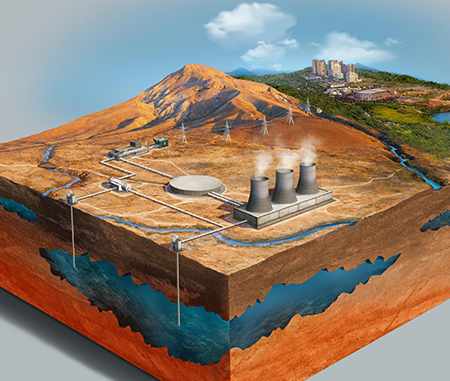
WHAT IS GEOTHERMAL ENERGY?
The heat generated from the earth’s sub-surface is referred to as geothermal energy. It’s found in rocks underneath the crust of the earth, as far down as its molten rock. Geothermal energy was first used in Italy in 1904, and since then, it has been a consistent and expansive energy source. Let’s see geothermal energy an untapped resource in Australia.
Producing geothermal energy requires wells being dug into the underground reservoirs by a mile to access the hot water and the steam to drive turbines connected to electricity generators. The three types of geothermal power plants; a binary, flash, and dry steam.
Dry steam extracts steam from the ground and uses that to drive a turbine. On the other hand, flash plants turn high-pressure hot water into cool, low-pressure water while binary plants pass hot water through a different liquid with a lower boiling point, which becomes the vapor that drives turbines.
WHERE IS GEOTHERMAL ENERGY USED?
Currently, over twenty countries use geothermal energy; the number one producer of geothermal energy globally is the United States. It also has the largest geothermal field. The largest geothermal area – The Geysers in California – spreads across 117 square kilometers and consists of 22 power plants, with over 1.5 gigawatts as of the overall installed capacity.
Iceland is a country that makes good use of geothermal energy. Their government has been using energy sources since 1907. They popularly refer to themselves as the pioneers of geothermal power, most likely because the country has five geothermal power plants that produce 25% of its energy. This is possible because of the high amount of volcanoes and hot springs in their nation.
USES OF GEOTHERMAL ENERGY
Geothermal energy use can be divided into direct-use applications, geothermal heat pumps, and electric power generation.
Geothermal energy is directly used to warm buildings, swimming pools, therapeutic facilities, greenhouses, and aquaculture ponds. It can also be used to cook, pasteurize milk, and dry fruits or vegetables.
BENEFITS OF GEOTHERMAL ENERGY
According to the British Geological Survey, geothermal energy is a “carbon-free, renewable, sustainable form of energy that provides a continuous and uninterrupted heat supply.” Geothermal energy produces only about one-sixth of the CO2 that a natural gas plant would emit. It is not intermittent like energy from solar or wind energy, and its potential could go as far as to 2 terawatts high.
Some drawbacks to the energy source include producing other harmful by-products like hydrogen sulfide and sulfur oxide. Geothermal plants, like fracking, are the causes of mini tremors in the areas they are located. The high initial cost to build is also a major con as it becomes non-viable financially. It is also the “most location-specific energy source”; countries like Indonesia, the US, Kenya, and Iceland are limited.
CONS – EXHAUSTION
Geothermal resources become exhausted when the rate of heat extraction exceeds the rate of natural heat discharge. Geothermal resources typically last up to 30 years, with the energy output decreasing with time. The Lardello geothermal field and the Geysers have supplied geothermal electric power from the early 1900s and 1960s. However, there has been a decline in both areas; the problem has been solved partially by drilling new wells and revamping the water supply.
GEOTHERMAL ENERGY IN AUSTRALIA
There is high potential for geothermal energy in Australia; however, it is not financially viable in Australia due to these challenges:
- Where can it be found? Identification of suitable geothermal resources.
- How to flow it?
- Who would finance it? Capital costs are associated with enhanced geothermal system technologies and the cost of transmitting electricity to remote locations.
Australia’s geothermal sector is still in its infancy, accounting for only 0.001 percent of its total renewable energy generation. In 2018, the commercial-scale geothermal technology in the Australian residential sector took a step forward, with Alinta Energy announcing plans to commercialize geothermal heating and cooling following a successful rollout in a significant housing development in the suburb of Blacktown.
FINAL THOUGHTS
Changing energy sources is necessary for ensuring the stability of specific neighborhoods in the future. The right way to do this is to use electricity compare in determining what energy provider is the most appropriate for a particular location. Using electricity compare would allow individuals and organizations to find areas where money can be saved regarding electricity supply. Geothermal energy is a cleaner renewable energy source than fossil fuel but not without drawbacks—thinking of switching to this form of renewable energy or another? An electricity comparison is what you need to make the decision more accessible and cost-effective.

Leave a Reply